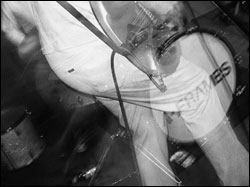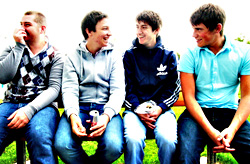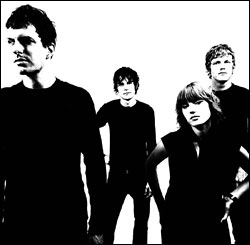This review begins with a child picking berries. The nearest meth lab is 10 miles away, in a tumbledown shack with peeling gray paint on the edge of an overgrown clearing near swampland. Closer to the child, who is rapidly discovering that the small red berries have an exceedingly bitter taste, stands a friendly looking double-wide mobile home, its spotless red tartan plaid ceramic-tiled exterior surrounded by peonies, marigolds, roses, sunflowers, and kale. Other double-wides, in a sustained conflagration of pattern and color, surround it on both sides of the lapis lazuli brick-paved lane that winds through the fashionable trailer court. The child begins to wonder if the berries might be poisonous and panics, tripping on a pear-shaped granite boulder inscribed with benedictions in a long-forgotten tongue. Staring up the gently sloping lane through tears, the fallen child sees them, soaring cathedrallike, right up to the bridge that leads to the geodesic dome in the forest: the A Frames.
On A Frames 2 (Dragnet), the real-life band occupies pretty much the same situation in its alternate universe as its architectural namesakes do in the story above: Beyond the trailers, but not quite in the wild. The Seattle band’s muscle-driven robotica is every bit as modular as the finest factory-built housing. The music’s basic elementsLars Finberg and Min Yee’s pistonlike rhythmic attack, Erin Sullivan’s straight-outta-Legoland riffs and deadpan vocals, the blocks and sheets of sound that form the compositions themselvesare far too variegated to be truly prefab, but still uniform enough from track to track so that every configuration of them on the album resembles every other in size, shape, and duration. Granted, pretty much all punk rock hews to similar conditions. The difference is that the A Frames make even their edges run together like clockwork. Techno should be this regular.
THE WORKS ARE in a cuckoo clock, though; from ‘droided-out lyrics to pile-driver beats, the A Frames are steeped in whimsy. Even Sullivan’s capacity for forging monolithic, mechanoid guitar parts every bit as potent as Steve Albini’s back in his Big Black days is turned toward lighthearted ends. The guitarist begins “We Are Abstract” with a single, rich chord, articulated like bursts from an automatic shotgun, then introduces the song’s linchpin, another chord, droning hugely, its upper and lowers halves alternating like the strokes of a milking machine. As the song progresses, Sullivan intones, “Negative/Subtract/ We are/Abstract,” the chord’s halves bleed together, and a crisply mutated section of “Ba, Ba, Black Sheep” rises to oppose the thaw, only to melt into a delay-driven trill pool at song’s end. Finberg and Yee repeat exactly the same one-measure part for the song’s duration.
The opposition between biological and mechanical elements in the song, between chaos and order, is perfectly balanced on “We Are Abstract,” as it is throughout the album. Even the apparent chaos of “Modula 2,” the album’s 34-second opening blast, conceals an underlying orderit’s the big bangthe pouring of the musical pieces that form A Frames 2 onto the living room floor like a canister full of Erector Set pieces. Despite its carefully crafted architechtonics, the album never seems overlabored or artsy. Instead, it hangs gracefully between current retro post-punk kitsch and the promise of a more scientific tomorrow.
EITHER SULLIVAN AND Finberg harbor multiple musical personalities or the addition of drummer Dean Whitmore was truly cataclysmic. How to Plan Successful Parties (Omnibus), recorded in 2001, presents the fruits of the labor of a spin-off A Frames band, the Dipers, in all its sprawling, lurching glory. Just as the A Frames’ position is informed by the likes of Wire, Joy Division, and Big Black, the Dipers bring to mind less tidy sources of inspiration along the lines of the Butthole Surfers and Jesus Lizard (not to mention Portland garage rock legends the Wipers, at least in name).
Sullivan, such a contained vocalist in the A Frames, howls, moans, caterwauls, and hollers as a Diper, with so much undomesticated energy that it’s not all that difficult to imagine him stage diving once or twice per song, even in the studio. His guitar work is just as untamednone of that carefully manicured A Frames stuff. Instead, he bashes and grinds through verse and chorus alike, pausing only to solo with enough abandon to make Doug Martschor even Ted Nugentblush like a nun in a buggers’ den. Only How‘s final track, “Feed My Habit,” provides a glimpse of things to come. The song’s prettyish, minor-key guitar figure, unvarying tom-tom-driven beat, and monotone vocals, equal proto-A Frames exhibit A in nearly every respect, save for Sullivan’s barking and the song’s serpentine flow, along with the extended trail of feedback that leaves the disc hanging at the end.
Which is exactly where it should be. It’s unlikely that the A Frames will ever summon full-strength versions of the devils that drive the Dipers. Their style is already too developed, too refined, for them to fall back on such a clamorous agenda. Still, the time could come when a more advanced manifestation of the Dipers’ messiness might serve the A Frames well. After hearing How to Plan Successful Parties, it’s hard to imagine Sullivan working within A Frames 2‘s strict modular constraints forever. He makes a great spooked guy from the future and all, and he’s one of the most clich魦ree guitarists in rock today. But lurking somewhere inside him is a party animal, just waiting for a chance to run around naked and knock things over, even as it propels torrential solos through a massive haze of effects and colors outside every vocal line it can find. Or maybe the beast’ll turn into a handsome prince, marry the now-grown child, and proceed to its factory-made castle for a heap of happily-ever-after living. Who cares? For right now, a little lighthearted modularity is exactly what the mechanic ordered.








